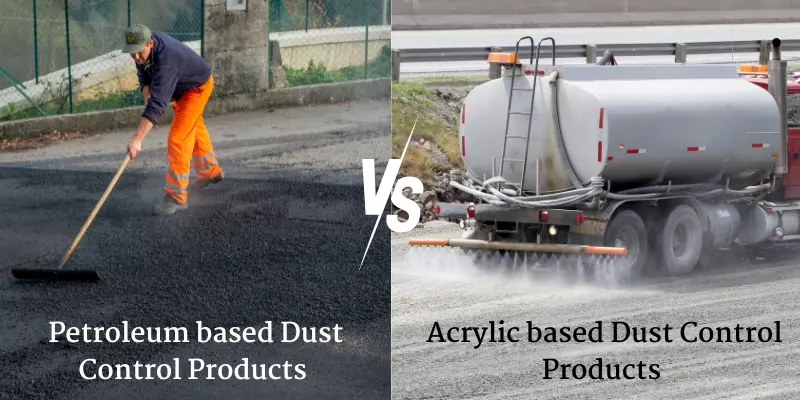
October 7, 2025
Drive down any gravel road in summer and the air tells the story: a thick plume of dust trailing every passing vehicle. For drivers, it reduces visibility. For nearby homes, farms, or businesses, it coats surfaces and drifts into water supplies. For agencies and operators, it accelerates road wear, raises complaints, and increases long-term costs.
Yet with tightening regulations and community pressure, knowing which dust control method truly fits your site and which might cost more long-term isn’t straightforward.
This guide shows when petroleum dust control products make sense, when acrylics perform better, and what to check before deciding—grounded in standards and guidance.
Understanding How Dust Control Products Work
Quick Definitions—Petroleum vs. Acrylic Polymers
Petroleum-based dust control products coat and penetrate the road surface to reduce particle lift-off. They’re appropriate where a cohesive film is desired and handling/cure requirements and maintenance implications are planned for.
Acrylic polymer dust control products bind fine soil particles into a hardened surface after curing, supporting longer service intervals in many settings.
Once the mechanisms are understood, the next step is to match each product to the conditions on the ground. The framework below outlines the core factors agencies and operators evaluate before choosing a product.
Chemistries at a Glance
| Product type | Mechanism | Best for | Practical notes |
|---|---|---|---|
| Water | Temporary wetting | Very short-term control | Frequent spraying needed |
| Chloride salts | Attract/hold moisture | Dry regions with adequate ambient humidity | Use care near water bodies |
| Petroleum oils | Film/penetration | Heavy-use roads where a cohesive film is acceptable and maintenance is planned for | Plan storage/handling and cleanup; SPCC may apply where on-site oil storage meets thresholds |
| Acrylic polymers | Bind fine soil particles after cure | Community-facing roads, mixed-use, private | Plan a short cure window (≈12–24 h) |
| Synthetic fluids | Penetration & cohesion | Harsh or remote settings | Follow manufacturer’s instructions closely |
Decision Framework: What to Check First
- Soil properties come first: The proportion of fine soil particles (measured by ASTM C117) and the Plasticity Index (ASTM D4318)drive whether a binder can create a durable matrix; several public guides specifically note that some palliatives need a minimum of fine particles and plasticity to bind effectively.
- AP-42 context for baseline dust potential: Use EPA AP-42 variables—silt content (s), vehicle weight (W), surface moisture (M), and mean speed (S)—to document baseline dust potential. After chemical stabilization, AP-42 models should not be used to estimate emissions; instead, they should be treated strictly as a pre-treatment context. Then weigh tradeoffs: petroleum programs may require SPCC planning where on-site oil storage meets applicability thresholds and discharge potential exists, and can create a dark asphaltic film that is harder to maintain if it crusts; acrylic polymer emulsions avoid oil-specific SPCC, tend to preserve the native appearance, and form a semi-rigid surface after a planned ~12–24-hour dry cure.
- Climate and scheduling: For acrylic polymers, plan a dry curing window (often ~12–24 hours) and keep traffic off until dry per agency guidance. Asphaltic/petroleum emulsions also need suitable weather and a clean, dry surface at application; follow the product TDS and agency specifications.
- Traffic and grades: Because acrylic polymers form a semi-rigid bound surface, agencies often select them for high-shear locations (e.g., steep grades, braking zones) when a cure window can be scheduled. Where dry-cure closures aren’t feasible, programs may use alternatives (including asphaltic emulsions or interim measures), provided weather and surface conditions meet specifications.
- Compliance & community optics: If a site stores petroleum oils above SPCC applicability thresholds with potential discharge to navigable waters, it must comply with 40 CFR Part 112. Asphaltic treatments can darken the surface, which some communities weigh in aesthetics reviews; polymer treatments form a film and often preserve the native aggregate appearance more than asphalt binders. Confirm local requirements and preferences.
These factors come together differently depending on where the product is used. The following use-case playbooks illustrate how agencies apply these principles across real-world scenarios.
Use-Case Playbooks
- County gravel roads: Acrylic polymer programs often reduce wateringand complaint volume on neighborhood corridors and, where no petroleum oil is stored on site above SPCC thresholds, avoid oil-specific storage/handling obligations; asphaltic binders darken the surface and, if a hard crust forms, are harder to maintain with a grader—issues many counties prefer to bypass on residential routes.
- Mining/haul roads: Acrylics can deliver durable control when applied under proper conditions and with scheduled downtime. Petroleum oils can reduce watering but may require more frequent rejuvenation under heavy truck traffic. Many programs schedule acrylic cures during low-traffic periods (e.g., shift changes).
- Construction sites: Petroleum is sometimes chosen for schedule flexibility, but do not assume zero curing delay—follow the product TDS and verify adequate cure before reopening; timing varies by product and weather. Acrylics require planning around a short, dry curing window, but once set, they maintain stability under ongoing traffic movements. Agencies sometimes choose options that don’t require a day-long dry cure to keep work moving; however, petroleum use can trigger oil-handling scrutiny and produces a darker surface. Acrylics need a short, dry curing window but yield a stable, often clear film that blends with the native aggregate afterward.
- Private/HOA roads: Appearance and track-out control dominate here. Asphaltic binders darken surfaces; polymer films preserve the native look and avoid oil-specific storage obligations where no petroleum is stored above SPCC thresholds. Use stabilized gravel pads and sweeping at paved tie-ins either way.
To summarize the distinctions across contexts, the table below compares how petroleum and acrylic products perform in typical site scenarios.
Scenario Comparison
| Scenario | Petroleum dust control | Acrylic dust control |
|---|---|---|
| County road near homes | Effective dust suppression; may alter surface appearance and can be difficult to maintain if a hard crust forms. On-site oil storage may trigger SPCC obligations where thresholds and a reasonable potential to discharge apply; used oil is prohibited for dust suppression. | Creates a semi-rigid binding film after curing; plan traffic diversion until dry (~12–24 h, weather-dependent); often selected where a non-darkened surface and straightforward, water-based handling are desired. |
| Haul road (heavy trucks, grades, braking) | Effective suppressant; limited strength gain at economical rates; potential maintenance difficulty if a hard crust forms. | After curing, the binding film increases cohesion; plan thorough surface prep and cure to handle heavy traffic and high-shear locations. |
| Active construction site | Follow the product TDS and verify adequate cure before reopening to traffic; reopening timing depends on product and weather (do not assume instant return). | Plan lane control for the curing window (~12–24 h); once cured, it provides a cohesive surface film suitable for temporary roads and pads. |
| HOA / private drive near residences | Appearance changes and oil-handling obligations may influence selection near homes. | Water-based, non-darkening film often aligns with residential expectations; maintain per product guidance. |
Notes:
- SPCC (40 CFR 112): Applies to facilities that store oil above thresholds (e.g., ≥1,320 gallons aggregate aboveground) with a reasonable potential to discharge to U.S. waters.
- Used oil: Federal rules prohibit using used oil as a dust suppressant (with very limited state-specific exceptions).
Understanding where each product fits sets the stage for applying them correctly. Success ultimately depends on preparation, application technique, and curing.
Application & Cure Requirements
- Surface preparation is the foundation: Both petroleum and acrylic products require a clean, well-shaped road surface free of standing water, ruts, and loose debris. For acrylics in particular, proper grading and compaction are essential to help the polymer bind fine soil particles into a durable surface. Petroleum products also need a stable, even base to perform as intended.
- Application technique shapes performance: Acrylic polymers are typically applied in diluted form through calibrated spray equipment to ensure even coverage
, sometimes in multiple passes. Petroleum (asphaltic) emulsions are applied as specified in the product data sheet—in some cases, undiluted and in others diluted—again using calibrated distributors to hit the target application rate and temperature.
- Curing is critical for acrylics: After application, acrylic-treated roads should remain undisturbed for roughly 12–24 hours while the surface dries. Reopen to traffic based on surface readiness—the surface should be dry with no pickup, rather than a fixed clock. For petroleum emulsions, also follow the manufacturer’s instructions and verify dryness/cure before reopening; actual timing varies by product and weather conditions.
- Maintenance expectations differ: Acrylic polymers often extend the interval between reapplications because they form a semi-rigid bound surface once cured. Petroleum treatments provide effective suppression but may require more frequent retreatment under heavy use, since they generally offer less strength improvement at economical rates and can be harder to maintain if a hard crust forms.
Once application best practices are established, the next consideration is cost—both upfront and over the lifecycle.
Costing Considerations
Evaluate the full lifecycle cost, not just per-unit price. Account for material and delivery, application labor and equipment, traffic control or lane closures, the expected reduction in reliance on frequent watering (vs. water-only programs), the cadence of maintenance reapplications, and any compliance or cleanup costs. Polymer programs may have higher material/freight costs in some regions, but well-designed chemical programs (including polymers) are associated with reduced maintenance bladings and fewer interventions when applied correctly. Petroleum emulsions are effective palliatives but typically provide limited strength improvement at economical rates—so rejuvenation can be more frequent on heavy-truck routes—and oil storage above thresholds (when on-site storage meets 40 CFR Part 112applicability and there’s a reasonable potential to discharge) can add SPCC planning.
Economic choices are only part of the equation. Environmental compliance and regulatory responsibilities shape long-term viability just as much as budget.
Environmental & Compliance Notes
Dust suppression improves safety (better driver visibility) and air quality (lower particulate matter).
- Petroleum use and SPCC: Petroleum applications may require SPCC compliance when on-site oil storage meets 40 CFR Part 112 applicability (for example, the 1,320-gallon aggregate aboveground threshold and a reasonable expectation of discharge).
- Track-out control: To minimize carryover, use short gravel pads at transitions and sweep paved tie-ins to control track-out.
- Appearance and handling: Because acrylic polymer emulsions are water-based, projects storing only acrylics avoid oil-specific SPCC obligations. Asphaltic petroleum treatments are typically dark/black and can change surface appearance, while polymers generally do not leave a bituminous black film (final appearance varies with the native soil).
- Protect waterways: All products must be kept out of ditches and streams per agency guidance and local requirements.
Beyond compliance, regional climate also influences performance, especially in high-sun areas where UV exposure can affect longevity.
In intense sunlight, polymer films can degrade over time. Schedule periodic inspections and light maintenance reapplications to maintain performance. Durability tells only part of the story. For community-facing roads, environmental impact and perception are often given more weight, along with technical performance.
Why petroleum dust control is often a poor fit near communities (and how acrylics avoid those drawbacks)
Petroleum binders (typically asphalt emulsions or cutbacks) work by coating and penetrating the road surface. They can suppress dust, but they come with obligations and tradeoffs that many programs try to avoid near neighborhoods and waterways. For one, facilities that store petroleum oils on site above SPCC thresholds and have a reasonable potential to discharge to U.S. waters must maintain an SPCC plan (typical triggers: ≥1,320 gallons aggregate aboveground or ≥42,000 gallons underground), adding paperwork, training, inspections, and secondary containment.
Regulators also draw a hard line against using used oil for dust suppression—federal rules prohibit it in most states because of contaminant risks; only limited, listed exceptions exist at the state level. Communities and road agencies, therefore, steer clear of “waste oil” applications.
Even when properly specified asphalt emulsions are used, agencies note maintenance challenges. Once a hard crust forms, asphalt-treated surfaces are difficult to maintain with conventional unpaved road equipment—a headache for graders and routine blading. Acrylic polymers, by contrast, bind fine soil particles into a semi-rigid film after curing, which is designed to resist traffic abrasion without forming a bituminous skin that fights maintenance.
Appearance matters too. Asphaltic binders darken the surface, which can be unwelcome on residential corridors; polymer films typically preserve the native aggregate look once cured.
Finally, track-out is a reality at paved tie-ins regardless of product, but hydrocarbon binders raise extra scrutiny. Stormwater BMPs specifically recommend stabilized gravel pads and wheel-wash at exits, with same-day sweeping if material is tracked onto public roads. Acrylic programs follow the same BMPs while avoiding oil-specific SPCC obligations where no petroleum is stored on site.
Bottom line: Petroleum binders can control dust, but they add regulatory exposure, darker surfaces, and maintenance friction. Acrylic polymers avoid oil-handling rules when only water-based polymers are stored, cure into a clear, semi-rigid film, and are generally easier to keep presentable in neighborhoods—provided you plan a short, dry curing window (~12–24 hours; keep traffic off until dry).
Durability tells only part of the story. For community-facing roads, environmental impact and public perception often outweigh technical performance.
Pilot Before Scaling
Select a representative test section and run a small pilot before full rollout. For instrumented evaluations, many programs use ≈300 m (~1,000 ft) or longer to get sufficient data; on small, low-volume roads, a shorter pilot can work if you can still observe and document performance. Record pre-treatment soil properties—% passing No. 200 (ASTM C117) and Plasticity Index (ASTM D4318)—along with EPA AP-42 baseline context(silt content s, vehicle weight W, surface moisture M, mean speed S). Log the product and application rate, weather, and the actual return-to-traffic time per the product data sheet (reopen only after cure criteria are met). Photograph at practical checkpoints (e.g., after cure ~24 h, at ~7 days, and after the first significant rain) to document performance. Where feasible, measure in-situ strength with ASTM D6951 (DCP) and convert to CBR using your agency’s accepted, locally calibrated correlation.
To make implementation smoother, below are some frequently asked questions about acrylic polymer treatments and best practices.
FAQs
- How long before traffic can return? Plan a single-workday cure (about 12–24 h) for acrylic polymer treatments, above freezing, and keep traffic off until the surface is dry per the product guidance.
- How often should I reapply? It depends on traffic and weather. Public guidance calls for periodic reapplication as needed per the product data sheet or your site plan (no universal seasonal/annual rule).
- Can I dilute it with salt water? The percentage of dilution of salt with water depends on the manufacturer’s guidelines. For critical projects, fresh water is safer, and any brackish mix should be pilot-tested on a short section first.
- Will rain wash off the treatment? After full cure, polymer-bound surfaces are more resistant to rainfall. If rain is likely during the cure window, delay application to protect performance.
With these practical considerations in mind, the choice between petroleum and acrylic dust control products becomes clearer.
Conclusion
Petroleum and acrylic products both have a role in modern dust control programs. When fast reopening and minimal downtime take priority, asphaltic treatments can serve a purpose—provided their handling, storage, and darker appearance align with project needs and regulations.
However, for agencies and operators seeking long-term performance, environmental alignment, and cleaner community presentation, acrylic polymer emulsions offer a clear edge. Applied on a well-prepared surface and allowed to cure properly, acrylic polymer emulsions can extend intervals between maintenance and typically avoid the bituminous black appearance associated with asphaltic treatments.
Start with a representative pilot, document results, and scale based on performance, community expectations, and applicable regulations (including SPCC when petroleum storage thresholds apply). For many projects that can accommodate curing, water-based acrylic polymer emulsions offer a practical balance of performance and compliance considerations.
Across the U.S. and worldwide, public agencies, private operators, and the U.S. Department of Defence rely on these polymer dust control approaches for their balance of durability, sustainability, and ease of compliance on roads, airfields, and helipads—evidence of their versatility across settings and climates.
If you’re evaluating options for your next project, explore our range of high-performance acrylic polymer dust control solutions—engineered for lasting results, proven across climates, and trusted by leading infrastructure programs.
Applications - Dust Control & Soil Stabilization Products


Leave a Reply